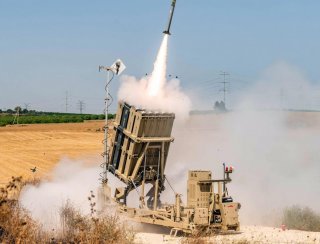Mark Episkopos

Here's What You Need to Remember: Iron Beam’s highly limited range means that it can never replace Israel’s existing missile defense architecture. It can, however, become a cornerstone of the IDF’s capacity to destroy very short-range missiles in general and counter mitigate saturation strikes in particular-- that is, if Israel gets around to completing it.
Iran’s bold summer campaign against U.S. allies and interests in the Persian Gulf-- including military support for Houthi rebels and an alleged drone strike against Saudi Arabia--has alarmed Jerusalem to the prospect of an imminent Israel-Iran conflict, shining a critical spotlight on the core pillar of Israel’s defensive deterrent against Iran: its anti-air systems.
The operational and logistical flaws in the Israeli Defense Forces’ (IDF) technically impressive, but expensive and unwieldy four-tiered missile defense shield have reignited Israeli interest in laser technology.
Contrary to popular belief, the concept of energy-based weaponry is neither novel nor futuristic. The Israelis have been evaluating a project along these lines since the early 2000’s, when a laser missile defense system was proposed as an alternative to the Iron Dome short-range air defense system. The Dome eventually won out, with the Israeli Defense Ministry concluding that laser technology had not yet matured into a cost-effective and operationally sound investment.
But Israeli defense firm Rafael Advanced Defense Systems resumed R&D work on a laser-based missile defense prototype in 2009. Rafael Systems unveiled an early concept model, named the Iron Beam high-energy laser (HEL), at the 2014 Singapore Air Show. That system employed dual multi-kilowatt solid-state lasers, compatible with any radar and capable of being mounted on a wide range of vehicles. Sources differ on precise details, but Iron Beam is currently thought to have a maximum effective range of up to seven kilometers and is reportedly capable of destroying missiles, unmanned aerial vehicles (UAV’s), or mortar shells around four seconds after the twin high-energy fiber-optic lasers make contact with their target.
The National Interest previously outlined two major problems facing the Iron Dome: poor cost-efficiency and vulnerability to swarm tactics. If it performs roughly as projected, Iron Beam has the potential to eliminate the first problem outright while greatly mitigating the other. When accounting for the price of the Tamir interceptor missile as well as all the redundancies designed into the system to minimize failure rates, every Iron Dome interception costs around $100,000 to $150,000. By stark comparison, Israeli defense commentator Zvi Shor told Defense IQ that every Iron Beam shot will clock in at a mere $2,000; another Israeli defense industry source called Iron Beam’s interception costs “almost negligible.”
The 2014 Gaza conflict shows that Israel’s adversaries have learned to exploit the Iron Dome’s weaknesses through saturated strikes, launching hundreds of rockets nearly simultaneously within several miles of Israel’s borders. Iron Beam counteracts swarm tactics by relieving Iron Dome from handling very short-range interceptions, a category with which the Dome has historically struggled. Iron Beam’s low interception and maintenance costs makes it affordable for the IDF to deploy more of them at a given time, making Israeli missile defenses harder to overwhelm.
Iron Beam’s highly limited range means that it can never replace Israel’s existing missile defense architecture. It can, however, become a cornerstone of the IDF’s capacity to destroy very short-range missiles in general and counter mitigate saturation strikes in particular-- that is, if Israel gets around to completing it. Iron Beam is currently sitting in bureaucratic limbo, one of several projects to be held hostage by an ongoing defense budget dispute.
No comments:
Post a Comment